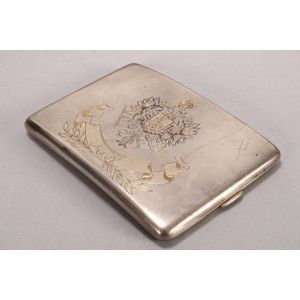Russian Silver Cigarette Box with Engraved Armorial Design
Russian silver cigarette box and cover, marked 84, Xeheba (in Cyrillic), of curved rectangular form, beautifully engraved with gilt and niello displaying a central armorial flanked by smaller armorials, with crowned double headed eagle verso, above ribbon scroll with initials 'M.P,' opening to gilt interior, total weight 118gm, 11.5 cm x 8 cm. Provenance: collection of the late Fredric Sinfield, Sydney NSW, 1938 - 2008
You must be a subscriber, and be logged in to view price and dealer details.
Subscribe Now to view actual auction price for this item
When you subscribe, you have the option of setting the currency in which to display prices to $Au, $US, $NZ or Stg.
This item has been sold, and the description, image and price are for reference purposes only.
- Verso - Verso is the "back" side of a sheet of paper, art work, coin or medal. The front side is "recto".
- Niello - A compound made up of lead silver copper and sulphur that is black in colour, and applied to the engraved areas of silver items, thus highlighting the engraving by making the black niello detail stand out from the silver background. It was used on edged weapons from the Renaisance onwards, and also by Russian crafstmen of the19th century.
- Armorial / Armourial - Bearing a coat of arms. Coats of arms came into general use by feudal lords and knights in in the 12th century, and by the 13th century, arms had spread beyond their initial battlefield use to become a flag or emblem for families in the higher social classes of Europe. They were inherited from one generation to the next. When a family crest is used on individual items of silver or furniture it is an indicator of the aristocratic standing of the family represented.
Armorials were also used to decorate mass produced ceramic souvenir ware by such companies as Goss, Carlton & Shelley, and in these cases the coats of arms displayed were of boroughs and cities.
This item has been included into following indexes:
